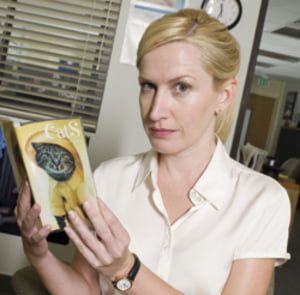All living things contain DNA. DNA is basically a chemical that contains all of the information about us (in code form.) DNA is what makes your hair start to turn grey on your 18th birthday. It is what causes your ear lobes to become attached or detached during the development process and it even determines the probability of certain genetic illnesses. All living things contain this protein strand. According to the US Department of Energy. These strands are tied together in pairs and produce a visual image of a double helix. The DNA strands are contained inside every cell in our body. These Strands are often referred to as the building blocks of nature. Every species of life is different. In humans their DNA contains 23 pairs of chromosomes. That means that there are 46 individual chromosomes. Each chromosome contains then contains 50 million to 250 million base pairs. When we compare that to a small bacterium which contains around 600,000 base pairs. That is roughly like comparing 600,000 to 3 billion. This explains the complex nature of humans and the simplicity of a basic bacterium.
Each chromosome contains genes. Genes are passed on from one generation to the next. However genes contain only 2% of the human genome, the rest actually provides structure for the chromosome and regulates the production of proteins. Proteins are very complex. Their basic function is to regulate chemical production. There are about 20 amino acids that help with this process.
The US Department of Energy has an area that specializes in genetic research they have an office known as The Office of Science. The US Department of energy had this idea to map out what every gene in the human body did. They were successful; they formed the HGP or the Human Genome project. The goal was to produce a map of the human body, identifying the entire genetic make up of humans. The sequencing is mostly complete; they now have all 23 base pairs mapped out and even include a list of genetic defects that occur in each pair. For example in base pair one there are 246 million base pairs. This chromosome is responsible for such genetic defects as cataracts and chondrodyplasia punctata rhizomelic type 2 and even measles. Chromosome 20 only contains 63 million base pairs. This is the chromosome that is responsible for breast cancer.
The HGP was launched in 1990. This originally began with two men Craig Venter and Sir John Sulston of Britain. Eventually a feud broke out between the two and president Clinton was asked to help settle the argument; he did. That began the official launch of the HGP Human Genome Project.
There are varieties of diseases that can be cured through genetic engineering. Genetic engineering is simply the changing of the genes; that caused the disease, or could potentially cause a disease or illness. If you fix the defective gene, you cure the disease. Remember that DNA determines everything about you. Not all diseases are genetic diseases; if it’s not a genetic disease then genetic engineering will be of no use. By genetically manipulating genes you could cure a disease. By genetically manipulating the gene before birth you could eliminate the possibility of ever getting the disease. Even as an adult some genetic illness’ can be cured 100% within one week. Genes could be changed as easily as taking a pill. Scientists and doctors have the ability to view the complete DNA strands of a fertilized egg. The results don’t show what diseases your child could catch but rather which diseases they were susceptible to. That is where the potential problems could lie. This is also where the cure is as well. A child who is susceptible to lung cancer would more than likely never have a problem unless he/she smoked. That could be cured with just the knowledge of the increased potential for the disease. On the other hand not all diseases have circumstances that can help you prevent them. Breast cancer is one. It is a genetic disease but, it isn’t caused by someone doing something that is bad for you. It just happens and it can be cured if the genes are altered. According to Windfall films, a production company hired to produce a TV series for PBS, there are a lot of benefits to genetic engineering. First of all we now have the ability to test our embryos for genetic illness potential. The procedure in some cases involves actually removing the fetus from the women and then performing the test. The fetus can then be placed back into the women where the mother will carry the baby to term. The procedure seems really complex. According to another television special on ABC “Fear of Designer Babies” this same procedure that was touted as complicated by PBS; was made to seem simple by ABC. The US Department of energy has done much to help settle any debates over the ethics between conflicting sides to the argument. They have been able to do what most private labs and research companies were unable to accomplish; that is to provide a lot of facts; the areas of genetic research that our government has chosen to spend a lot of money on involve the ethics and procedures used or potentially used for genetically testing and engineering humans.
NBC news published an article on the ethics of testing babies for potential genetic problems. They have poised a very serous question “…27 year old women decided to have her embryos screened for an inherited gene that would have left the baby would a 50% chance of developing breast cancer. The women has a long history of breast cancer and her husband tested positive for the gene.” According to that, there should be nothing ethically wrong with testing the fetus to determine weather there is a potential for the disease. Davis Masci, journalist mentions that there seem to be a whole array of things that could ethically go wrong, or right. He has studied both sides of an ethics argument and has come out with some pretty interesting facts. It is possible to redesign a human to live 150 even up to 300 years. Is it ethical? That would depend on weather the individual was happy or not. I think that is a very good ‘meter stick’ to measure the ethical outcome of genetic engineering. Some people are saying that regardless, we are still “playing god” and that until the long term effects on society are studied that we really wont know the full outcome. Once we genetically alter something, those altered genes are passed along to there off spring. It could be argued that by just changing a few people we could change an entire race of humans. This “ripple effect” would eventually work into all areas of society.
To test or not to test, that is the question. Then what do you do with the results? Well, in the case earlier mentioned; the 27 year old women with the fetus who has a 50% chance of getting breast cancer, testing is obviously a good thing. This wasn’t a test for intelligence or attractiveness. This was a test for a disease, or the potential to get one. The child tested negative for the faulty gene. Even a positive test for a bad gene doesn’t mean that you will definitely get the disease, it does mean that you should be on the look out for it. The scientific community is in great fear of this technology getting into the hands of the wrong people; it could be potentially used to create a superior race. Although, the scientists really don’t think we have the ability to do that, David Masci mentions that the scientists think that while we improve certain qualities of an individual other qualities will disappear. They don’t seem to think we could make a ‘superior’ race. The benefits of being able to do this kind of testing are that we could determine which diseases to be on the look out for when our children are born. The other is that there are a lot of genetic problems that could be fixed later on in life, just by taking some medication. This isn’t what comes to mind when we talk of genetic engineering. We are thinking of Aldous Huxley’s Brave New World. We are thinking about government control as in the movie GATTICA. The scientists are also thinking along those lines but according to Masci’s report on designer humans, ABC news, PBS and the US Department of Energy all have agreed that we are still another 10 years off from producing perfect humans.
In Masci’s report he quotes several a Sharon Terry from the US Department of energy. Sharon mentioned that the government has stopped all efforts on human cloning. She also mentions that we are still investigating the possible ramifications of human cloning. We are also concerned about the overall safety of the whole process. The way the US Department of energy is focusing on the moral issues is they are questioning “the very essence of what it means to be human.” That means that all the money that we were going to use to clone humans has been diverted to more of a research side of the cloning process (specifically human cloning.) We are in dire need of addressing all aspects of cloning. The issues of how to safely genetically manipulate human’s genes are the starting point for most scientists. We have been cloning; which is at the extreme end of the genetic engineering scale (not in humans.) It seems that it is ok to use genetics to test a fetus in a high-risk category for a disease. It is not ok to create a human designed to kill. Somewhere in the middle should lay the uses and methods used for genetic manipulation. There really is no governing body that has laid out the rules for genetic engineering. The science as we know it today is fairly new. Its original roots began in the 1860 with a man named Gregory Mendel. He was a Monk living in Austria. He discovered the basic laws of genetic inheritance. We have known for some time how genes are passed along. We now know how to change, or repair the broken ones. Right now the scientific community is readily accepting the use go gene manipulation and testing in un born fetuses as well as newborn babies. So far the testing procedures have been deemed ethical. There have been a few issues raised in fertility clinics. They are able to fertilize the egg with the sperm in a petre dish. Once that is done they can test it to determine certain factors like hair or eye color. They can determine which genes are faulty and which ones are great. They can already and they currently do this in a lot of private fertility clinics. They aren’t controlled by anybody and are into such a new technology that people can’t even figure out who should control them. Once the process of determining what type of off spring the parents will conceive the egg can be placed in the mother where the child will be delivered full term; with the parents knowing a whole lot about their child. They didn’t genetically change anything but; the parents do have the option of trying a different combination of sperm and egg if they aren’t happy with the first test results. That brings forth a whole bunch of other moral issues.
There is the belief that parents will always do what is right for their children and should be trusted to make judgment calls in regards to their children’s health and well being. “Parents will still be parents,” continues professor lee silver a molecular biologist at Princeton University. The notion that parents are going to make better decisions and well informed decisions balances on the facts and the knowledge that the parents have about the individual circumstances. While I’m sure that picking the hair color and eye color may be an option I really think that the biggest concern and use for this technology should be used diagnosing and curing fatal illnesses. There is even an argument governing what is fatal illness. Some doctors are saying that it should include life-changing illnesses as well. A great example of this would be mental retardation. I cannot think of any reason why that gene shouldn’t be repaired before birth. With limitations gene therapy could be a great thing. Even if it’s just testing an egg and sperm to make sure that there is nothing life threatening that is going to happen to the baby. There is always that doubt that is placed in there with genetic testing, just because the fetus has the bad gene doesn’t mean they are going to contract the specified disease.
These solutions only raise more questions. Let’s say you know your unborn child has a genetic defect that could cause him to have Huntington’s disease, a very bad genetic illness that comes with a death sentence. Knowing this in advance could cause you to raise the child differently. Maybe you don’t let him play football at fear that he may get hurt. Maybe you won’t let her move out when she turns 18 because you want to keep her in your sight. Those are just a few possibilities of knowing the potential fate of another individual.
The critics are in fear of increasing the social classes of people. The way it works is that half of the people enhance their children while the other half of the population doesn’t. The half that doesn’t chooses not to because of moral, religious or ethical reasons. Now we have a society that is half superior while the other half (in comparison) would be deemed inferior. The superior children end up with all the really great jobs while the inferior children have to struggle. We could potentially end up with two classes of people. That also ties into the affordability of genetically altering our children. If this is something you wanted to have done; it would more then likely be very expensive, at least for a while. That would mean that only the rich could afford to have it done. That too could potentially be damaging.
The experts are questioning weather or not smarter equals happier. If we genetically enhance our children to make them smarter does that make them happier? That is a really tough thing to prove. We know that there are a lot of children with downs syndrome who are very happy and we also know that there are a lot of very smart people who aren’t happy. It would have been acceptable to test the child with downs syndrome and remove that gene before the child was born. In that particular circumstance, it wouldn’t be used for vanity purposes. That is for survival. The US Department of Energy is saying, “Gene tests can be used to diagnose and confirm disease, even in asymptomatic individuals; provide prognostic information about the course of the disease; and, predict the risk of future disease in individuals or their progeny.” They mention that there are 100,000 people that die each year of prescription related deaths. It would be nice to not to have to drug up our children; we could cure the problem at its epicenter, right where it started in the gene.
Back to the argument or rather the question what makes us human? I think the scientific approach would be the best to start out with. We need to understand how a living cell works. Contained within the living cell is the “parts list” for the human. It has all the directions that the body needs in order for it to come alive and build itself. It really is quite remarkable. Now, that cell is living already yet it has the instructions and tools to continue on living. Science says that something is alive at a cellular level (not the kind of alive that we are thinking of, it just exists just as a bacteria exists; and not a whole lot different at that level.) The amazing thing is that the “parts list” and the blue print contained within every cell are capable of building an entire body. The variations in genetic patterns across populations are currently being studied by the US Department of Energy, Office of Science. It turns out that “slight variations in our DNA sequences can have a major impact on whether or not we develop a disease and our response to environmental factors…” The environmental factors they are referring to are things like infections, toxins and even drugs. These slight variations in DNA code make it a little bit more difficult to test for every genetic disease in the fetus. The standard DNA test will be able to test for a lot of different genetic diseases. The problem is that the tests can be broken down even further. Scientists think the average human has at least 10 million SNP’s or single nucleotide polymorphism. Basically that is taking the tiny little chromosome and further breaking it down to smaller and smaller units. This recent discovery was made in 2005. It involved a team of scientists from six countries. The team studied patterns of illness across the world and attempted to link the patterns to the defective gene. They found a great deal of evidence that showed that people in certain regions were born with a higher rate of certain genes being defective. This is fairly new research and a lot of information is still missing; maybe there really is something in the water.
Roger Fortuna of ABC news stated that, the testing for life threatening genetic illnesses should be a priority if; the possibility of the off spring getting the disease is higher than that of the average person. He has also stated that it could get a little bit out of hand and that a line should be drawn somewhere.
PBS blurts out in bold type across the top of its story “curing cancer” that “Bud Romine was diagnosed with incurable cancer in 1994. He was given three years to live. In 1996, a newspaper article caught his eye.” According to Windfall production company a doctor was testing a new type of cancer drug “Gleevec” within 17; days Buds cancer was completely cured and never came back. The drug Gleevec is a gene-altering drug. The way it works is to repair the defective gene effectively stopping the spread of cancer. This drug is so good for this very specific rare cancer that if a child were to be born with the defective gene it could be fixed later on in life. This perspective adds a different approach to look at gene testing in the fetus. This brings up the points that if we can cure something later on in life with a pill then why test on the unborn fetus? Alas, it is true there are at least three sides to every argument.
The US Department of Energy stands behind a philosophy that “knowledge about the risk potential future disease can produce significant emotional and psychological impacts.” This is because genetic testing can tell a lot about a person. If you agreed to be genetically tested they would literally know everything about you, or at least everything that makes you…you. Consequently the dynamics of the family directly affect the outcome of such testing. There is a psychological side to the testing, which is huge, according to the US Dept. of Energy. It seems there are more hurdles to overcome then merely being tested or testing a fetus for a genetic disease. The possibility also lies in that you just may learn something about yourself. Before they test the fetus they look into the background of the mother and father to see if there are any common ailments that run in the different families. In a lot of cases the testing of both parents may be required. They can then take the combined information and determine if the fetus is at risk for anything. If it is then the genetic engeneers and parents are faced with some options. They could terminate. They could repair the damaged DNA while the child is in the womb. They could do nothing and live with the knowledge that they could have prevented the disease from ever forming. Then again maybe genetically engineering the fetus would have caused other damage. David Masci reminded us earlier that even altered genes are passed down to off spring. If you change the gene in your child, you have changed the building code for the child; you have changed the instructions and have even altered the tools in the “toolbox.
So, now what? Currently if a child is at risk of getting a genetically inherited disease there is help available. That is the job of a geneticist. A geneticist is an M.D. specialty position. Help is also available in the form of counseling they are called genetic counselors; the qualifications for the position are graduate-degree training. They could explain the current options and treatments that are available.
The idea of being able to pick out the sex of your child seems like a great one. It would be nice to make them free of physical birth defects as well as the potential to get diseases. It would be great to determine the eye color or hail color. In fact everything you could think of could be pre determined. There is some concern over parents claiming ownership over certain children, since they technically created them. Most scientists have the same concerns in regards to genetic engineering. Most want someone of oversee them; they want someone to tell them what is right and what is wrong. This seems to take the pressure off the scientists. I personally am ok with the genetic testing of the fetus. I think I can live with myself knowing I tested the fetus. At the very least you could make informed decisions from the test results. For example I mentioned earlier that tests were made all over the world to see why certain children were born with certain defective genes. If I noticed that the fetus had or was developing or had developed the tendency to get cancer I may consider moving to an area in the world where that tendency towards that disease was less common. I could take the test results and inform my child that “you really shouldn’t smoke because you are 200 times more likely to develop lung cancer that the average person.” I think that if DNA testing was just used to inform; then millions of lives could be saved. Just the knowledge of “hey, I need to be a little bit extra careful” is sometimes enough to save a life. As far as testing because a parent wants the next beauty pageant winner, I think that is crazy. There is no need for that type of vanity. So, that rules out choosing the hair color, eye color and the sex of the baby. As far as minor birth defects go that falls into the vanity category. But, this is where I differ. If the fetus is tested and is determined to have a life or death illness or an illness that wont allow them to function in a normal society then I say yes. Genetically alter the genes. At this point I bring up the question…can this be cured after birth? If it can still be altered after birth then the genetic manipulation should wait. Maybe the child wont be born with the disease after all. Only under these most extreme circumstances should the genes of an un-born fetus be messed with. The reason for this was the study put out by our own government, The US Dept of Energy, office of Science. They actually put it best when they stated that they discovered this ‘sub gene’ basically the gene of a gene. Wow, I hope the scientists realize this; they have sure failed to mention it. Either way, until more research is conducted, repairing someone’s genes could end up being a big mistake and should only be used in the most extreme circumstances.
Works Cited
“DOE Office of Science.” DOE Office of Science. Government. .
Fortuna, Roger. “The ethics of testing embryos for disease.” Genetic testing helps British Women Conceive Breast cancer free baby. ABC News. 30 June 2008.
“Genomics GTO Road Map.” Genomics GTO Road Map. 2005. geonomicsgtl.energy.gog/roadmap/.
Human Genome Project. USA. US Department of Energy. Office of Science. Oak Ridge, TN: DOE Geonomics:GTL.
Masci, David. Designer Humans will altering human genes divide society?” CQ Researcher 11 (2001): 1-23. Masci, David. “Should the federal government ban human clone research?”
Interview. Designer Humans 18 May 2001: 13-15.
Massarella, Carlo. “DNA.” PBS. 2003. PBS. pbs.org/wnet/dna.
Silver, Lee M. Remaking Eden How genetic engineering and cloning will transform the American family. Avon, 1998.







